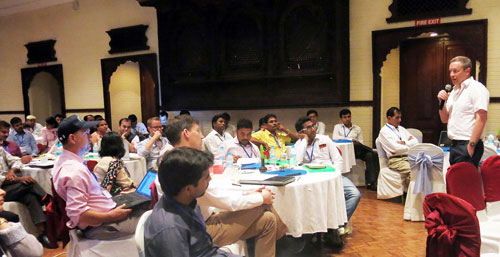As Phase II of the Cereal Systems Initiative for South Asia (CSISA) draws to a close in India, it is well positioned for a Phase III, according to Andrew McDonald, CIMMYT Cropping Systems Agronomist and CSISA Project Leader speaking at the Objective 1 planning and evaluation meeting for the 2015 monsoon cropping season held in Kathmandu, Nepal, on 22-24 April. The meeting was attended by CSISA’s Objective 1 teams from the Bihar, eastern Uttar Pradesh, Odisha and Tamil Nadu hubs, comprising diverse disciplinary experts from CIMMYT, the International Food Policy Research Institute (IFPRI), the International Livestock Research Institute (ILRI) and the International Rice Research Institute (IRRI).
Phase II began in October 2012 and will be completed in October of this year. The external evaluation report, commissioned by the United States Agency for International Development (USAID), commended the uniqueness of CSISA’s work with service providers and farmers, its staff’s dedication and the strong collaboration among CSISA partners. CSISA was established in 2009 to promote durable change at scale in South Asia’s cereal-based cropping systems, and operates rural “innovation hubs” throughout Bangladesh, India and Nepal.
The teams took a critical view of activities from the previous monsoon cropping season and highlighted priority areas for this year. “Sustainable intensification of cropping systems should be the centerpiece of our growth strategy. Rice followed by mustard followed by spring maize or green gram is a great system that can help us achieve 300% cropping intensity,” said R.K. Malik, CIMMYT Senior Agronomist and CSISA Objective 1 Leader. “We need to focus not only on how to create new service providers but also on how existing ones can be used as master trainers. This will help fill the gap of field technicians and further strengthen delivery,” Malik explained, regarding CSISA’s network of more than 1,800 service providers.

Leading discussions on the Odisha hub, Sudhir Yadav, IRRI Irrigated Systems Agronomist, emphasized the importance of identifying the non-negotiable steps for successful technology implementation. “The performance of zero tillage, for example, depends on soil type, date of seeding and whether the crop is rainfed or receives supplementary irrigation,” said Yadav. CSISA successfully introduced zero tillage in Odisha’s Mayurbhanj District, where it has enabled crop intensification thanks to the retention of residual soil moisture.
The meeting served as a platform for representatives from Catholic Relief Services’ (CRS) Improved Rice-based Rainfed Agricultural Systems project to showcase lessons in managing rainfed rice systems in northern Bihar.
CSISA is currently in discussions with USAID and the Bill & Melinda Gates Foundation (BMGF) to design the technical program, and determine the scope, geography, duration and budget of Phase III.
 Capacity development
Capacity development 
